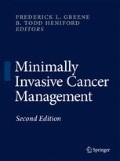Abstract
The history of the application of pneumoperitoneum is fascinating from the aspect of both diseases treated with this concept and the development of abdominal air insufflation from a technical standpoint [1]. The name George Kelling is woven into the modern use of pneumoperitoneum for patients undergoing laparoscopy. Kelling, like many of his contemporary colleagues, considered that pneumoperitoneum might have therapeutic use. He advocated the use of this technique, which he called lufttamponade, for the treatment of patients with significant intestinal and intraabdominal bleeding. Kelling placed a cystoscope into the abdominal cavity of animals to identify organ ischemia, which may be secondary to aggressive instillation of intraabdominal room air.
Access this chapter
Tax calculation will be finalised at checkout
Purchases are for personal use only
References
Litynski GS (1996) Anonymous highlights in the history of laparoscopy. Barbara Bernert Verlag, Frankfurt, pp 15–33
Andrus CH, Wittgen CM, Naunheim KS (1994) Anesthetic and physiological changes during laparoscopy and thoracoscopy: the surgeon’s view. Semin Laparosc Surg 1:228–240
Horvath KD, Whelan RL, Lier B et al (1998) The effects of elevated intraabdominal pressure, hypercarbia, and positioning on the hemodynamic responses to laparoscopic colectomy in pigs. Surg Endosc 12:107–114
Ho HS, Gunther RA, Wolfe BM (1992) Intraperitoneal carbon dioxide insufflation and cardiopulmonary functions. Laparoscopic cholecystectomy in pigs. Arch Surg 127:928–933
Shimotakahara A, Kuebler JF, Vieten G, Kos M, Metzelder ML, Ure BM (2008) Carbon dioxide directly suppresses spontaneous migration, chemotaxis, and free radical production of human neutrophils. Surg Endosc 22:1813–1817
Ikramuddin S, Lucas J, Ellison EC, Schirmer WJ, Melvin WS (1998) Detection of aerosolized cells during carbon dioxide laparoscopy. J Gastrointest Surg 2:580–584
Johnstone PA, Rohde DC, Swartz SE, Fetter JE, Wexner SD (1996) Port site recurrences after laparoscopic and thoracoscopic procedures in malignancy. J Clin Oncol 14:1950–1956
Knolmayer TJ, Asbun HJ, Shibata G, Bowyer MW (1997) An experimental model of cellular aerosolization during laparoscopic surgery. Surg Laparose Endosc 7:399–402
Lee SW, Southall J, Allendorf J, Bessler M, Whelan RL (1998) Traumatic handling of the tumor independent of pneumoperitoneum increases port site implantation rate of colon cancer in a murine model. Surg Endosc 12:828–834
Mathew G, Watson DI, Ellis T, De Young N, Rofe AM, Jamieson GG (1997) The effect of laparoscopy on the movement of tumor cells and metastasis to surgical wounds. Surg Endosc 11:1163–1166
Evrard S, Falkenrodt A, Park A, Tassetti V, Mutter D, Marescaux J (1997) Influence of CO2 pneumoperitoneum on systemic and peritoneal cell-mediated immunity. World J Surg 21:353–357
Jung IK, Kim MC, Kim KH, Kwak JY, Jung GJ, Kim HH (2008) Cellular and peritoneal immune response after radical laparoscopy-assisted and open gastrectomy for gastric cancer. J Surg Oncol 98:54–59
Kurz A, Sessler DI, Lenhardt R (1996) Perioperative normothermia to reduce the incidence of surgical wound infection and shorten hospitalization. N Engl J Med 334:1209–1215
MacFadyen BV Jr. (1999) Hypothermia: a potential risk of CO2 insufflation? Surg Endosc 13:99–100
Figueredo E, Canosa L (1997) Can hypothermia be evidenced during laparoscopic cholecystectomy? Surg Laparosc Endosc 7:378–383
Volz J, Köster S, Spacek Z, Paweletz N (1999) Characteristic alterations of the peritoneum after carbon dioxide pneumoperitoneum. Surg Endosc 13:611–614
Greene FL (1998) Pneumoperitoneum in the cancer patient: advantages and pitfalls. Semin Surg Oncol 15:151–154
Nussey SS, Bevan DH, Ang VT, Jenkins JS (1986) Effects of arginine vasopressin (AVP) infusions on circulating concentrations of platelet AVP, factor VIII C and von Willebrand factor. Thromb Haemost 55:34–36
Trokel MJ, Bessler M, Treat MR, Whelan RL, Nowyrod R (1994) Preservation of immune response after laparoscopy. Surg Endosc 8:1385–1388
Whelen RL, Franklin M, Holubar SD et al (2003) Postoperative cell mediated immune response is better preserved after laparoscopy vs. open colorectal resection in humans. Surg Endosc 17:972–978
Neuhaus SJ, Ellis T, Rofe AM, Pike GK, Jamieson GG, Watson DI (1998) Tumor implantation following laparoscopy using different insufflation gases. Surg Endosc 12:1300–1302
Reymond MA, Schneider C, Hohenberger W, Köckerling F (1998) The pneumoperitoneum and its role in tumor seeding. Dig Surg 15:105–109
Stocchi L, Nelson H (1998) Laparoscopic colectomy for colon cancer: trial update. J Surg Oncol 68:255–267
Goldberg JM, Maurer WG (1997) A randomized comparison of gasless laparoscopy and CO2 pneumoperitoneum. Obstet Gynecol 90:416–420
Neuhaus SJ, Watson DI, Ellis T, Dodd T, Rofe AM, Jamieson GG (1998) Efficacy of cytotoxic agents for the prevention of laparoscopic port site metastases. Arch Surg 133:762–766
Watson DI, Mathew G, Ellis T, Baigrie CF, Rofe AM, Jamieson GG (1997) Gasless laparoscopy may reduce the risk of port-site metastases following laparoscopic tumor surgery. Arch Surg 132:166–168
Schöb OM, Allen DS, Benzel E et al (1996) A comparison of the pathophysiologic effects of carbon dioxide, nitrous oxide, and helium pneumoperitoneum on intracranial pressure. Am J Surg 172:248–253
Author information
Authors and Affiliations
Editor information
Editors and Affiliations
Rights and permissions
Copyright information
© 2009 Springer Science+Business Media, LLC
About this chapter
Cite this chapter
Greene, F.L. (2009). Pneumoperitoneum: Metabolic and Mechanical Effects. In: Greene, F., Heniford, B. (eds) Minimally Invasive Cancer Management. Springer, New York, NY. https://doi.org/10.1007/978-1-4419-1238-1_3
Download citation
DOI: https://doi.org/10.1007/978-1-4419-1238-1_3
Published:
Publisher Name: Springer, New York, NY
Print ISBN: 978-1-4419-1237-4
Online ISBN: 978-1-4419-1238-1
eBook Packages: MedicineMedicine (R0)

